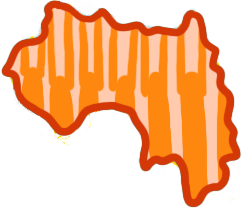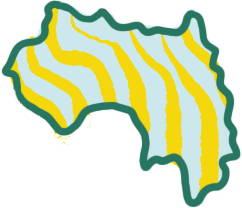Text
Thus far, we haven’t done any formal study of Maninka’s Latin-based alphabet. That’s because, in general, it something that is easy for English speakers to pick up as they go.
Still, it can be useful to formally look at the alphabet to get acquainted with all the letters that are the basis for the correct spelling of Maninka words, including the so-called special characters (e.g. ɛ, ɲ, ɔ).
Here, I won’t cover everything that one needs to know about Maninka’s spelling system (e.g., lengthening, nasalization, etc). That will have to be for future lessons. For now, we’ll simply cover the base letters!
Some Context
The Latin-based alphabet that we’ll cover here is what has been official in Guinea since 1989 when the country updated a prior system that had been developed and used in the decades following independence in 1958.
(NOTE: In reality, there wasn’t one post-independence system. Because the officially proposed one could not easily be typed at the time, a secondary one using easily typed alternatives was also used. The official one remained in use for handwriting.)
Similar systems are official in Burkina Faso and Côte d’Ivoire for Jula and in Mali for Bambara. All of them have origins that go back to the 19th century when Western Christian missionaries, colonial agents and later academic linguists first begin to use the Latin script to write down Manding varieties such as Maninka.
In this sense, it is also important to state that the Latin-based system that I’ll present here is not the only way to write Maninka or Manding in general.
Any serious student of Manding will eventually want to learn to write not just in the Latin script, but also in N’ko. Invented in 1949 by a man named Sulemaana Kantè, N’ko is not an alphabet for Maninka, but a standard writing system meant for all the Manding varieties: Bambara, Jula, Maninka and Mandinka.
(NOTE: If you are interested in learning the N’ko script, see the "The N'ko Alphabet" or this video tutorial that I made on how to write the letters by hand).
Ok, with that said, let’s jump into the letters and sounds of the Latin-based alphabet!
The Latin Alphabet
The tables below lays out the consonants and vowels. I’ve included some footnotes for additional information regarding some letters that can be tricky for pronunciation, spelling or typing.
Consonants
| Letter | English approximation | Example | Gloss |
|---|---|---|---|
| b | bad | ba |
river |
| c1 | chump | ceɲin |
beautiful |
| d | dog | da |
mouth |
| f | film | fali |
donkey |
| g2 | good | gerefe |
grafted mango |
| gb | *A "labio-velar double occlusive—in essence, an English /g/ and /b/ at the same time3 | gbɛlɛn |
difficult |
| h | hello | hɛrɛ |
peace |
| j4 | jump | je |
melon |
| k | kick | ko |
affair; issue |
| l | lamp | lolo |
star |
| m | might | malo |
(uncooked) rice |
| n | never | ni |
and |
| ɲ5 | *Palatal nasal—like enseñar in Spanish | ɲɔ |
millet |
| p | power | petu |
sandal |
| r6 | *a tapped /r/ like pero in Spanish | baara |
work |
| s | soup | so |
town; village |
| t | tomato | to |
leave |
| v7 | vitamini | vitamini |
vitamin |
| w | west | wari |
money |
| y | yogurt | yan |
here |
| z8 | zebra | Zan |
Jean |
Another special letter that is not present officially in Latin-based Maninka, but they you may encounter in Bambara or Jula texts is the following:
| Letter | English Approximation | Example | Gloss |
|---|---|---|---|
| ŋ9 | king | ŋɔni (in Bambara; in Maninka: womi) |
thorn |
Vowels
| Letter | English Approximation | Example | Gloss |
|---|---|---|---|
| a | wasp | baba |
dad |
| e | *like manger in French | bere |
stick |
| ɛ10 | met | bɛrɛ |
gravel |
| i | happy | nisi |
cow |
| o | *like beau in French | bolo |
arm |
| ɔ11 | caught12 | bɔlɔ |
stake; picket |
| u | goose | muru |
knife |
-
In the original post-independence orthography, the sound
cwas notedty.↩︎ -
In writing,
gby itself is rare in Maninka. It mostly appears at the beginning of a few loanwords. Even if it is not written though, you may hear it between vowels. Ag-like sound is often heard beween matching vowels in and around cities such as Siguiri. For instance:daa‘pot; jug’ may also be pronounceddaga. Or-tii‘owner’ may pronounced-tigiIn other areas, the sound between the two matching vowels may be pronounceddaka/daxaor-tiki/tixiwith no change in meaning.↩︎ -
If you have trouble pronouncing
gb, it is best to usegworgin its place. Otherwise, someone may hear you pronunciation asbwhich is not considered the same sound at all. This lines up with the practice of Bambara speakers. The sound and spellinggbdoes not exist in Bambara. Its equivalent is generallygorgw. For instance,gbɛlɛnVSgɛlɛn/gwɛlɛn‘difficult’.↩︎ -
In the original post-indendence orthography, the sound
jwas noteddy.↩︎ -
This letter,
ɲ(“palatal N”), represents a sound that we don’t have in English, but that many people know because of Spanish words where there is a tilde over an “n” such as mañana or niño. If you can’t type the letter, you can get away with the older convention of simply writingny.↩︎ -
The letter
rdoes not appear at the beginning of words normally. There is also an “instable R” that freely varies with D in people’s speech:rɔVSdɔ‘in’. It most often occurs between two identical vowels:sidiVSsiri‘tie; attach’. The most recent spelling proposals out of Guinea call for usingdby convention in such cases.↩︎ -
The letter
vis not officially in Maninka, but sometimes used for French loan words suchvitamini(‘vitamin’) orvitɛsiFr. vitesse ‘speed’). Generally, one writes loan words that havevin them with thew.↩︎ -
The letter
zis not officially in Maninka. It is a marginal phoneme, but sometimes used in loan words such as the French name Jean given here.↩︎ -
The letter
ŋ(“velar N”) represents a sound like the end of the word “king”. Now try to extract that and put it at the beginning of a word likeŋɔmi. In practice, you can normally get away with trying your best or simply using awsound in its place since historically they were one sound. In terms of typing, when people can’t access the proper Bambara letters, they often use an older conventionngin its place. In Maninka, these sound/letter is generally just asw.↩︎ -
In a pinch, people often write
ɛ(“open E”) using the older conventionè.↩︎ -
Similarly, when you can’t access the special character
ɔ(“open O”), you can use the older Maninka convention oföor the older Bambara convention ofò.↩︎ -
Not all American English speakers pronounce “caught” with
ɔ. If you make a distinction between “cot” (as in, a simple bed for naptime) and “caught” (as in, “I caught the ball”), then it is the latter.)↩︎
How to type in Maninka's Latin Alphabet
In this course, you don't need necessarily need do anything special to type in Maninka's Latin-based alphabet. This is because the exercises include a little pop-up for the "special characters": ɛ,ɔ, ɲ (and possibly ŋ though it is not officially part of Guinean Maninka spelling). That said, if you want to be able to type on your own, here's a write-up with various solutions depending on your device (The page speaks of "Bambara" instead of "Maninka", but all the keyboards work for both varieties).
Vocab
Coming soon n'Ala sɔnna!
- ɛ
- open e pronunciation
- bɛrɛ
- gravel
- bere
- stick
- ɔ
- open o pronunciation
- bɔlɔ
- stake
- bolo
- arm
- ɲ ("ɲa")
- palatal n pronunciation
- ɲin
- tooth
- ŋ ("ŋa")
- velar n pronunciation
- ŋɔni
- thorn
Vocab list will be here someday!
Flashcards will be here someday!
Exercises
Exercises will be here someday!




